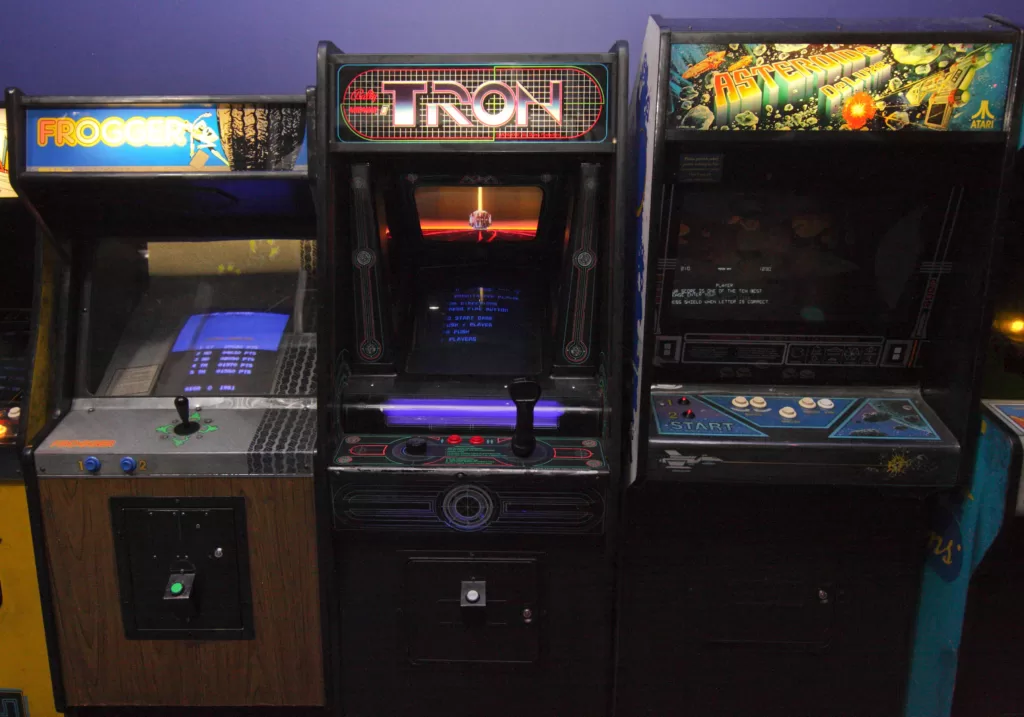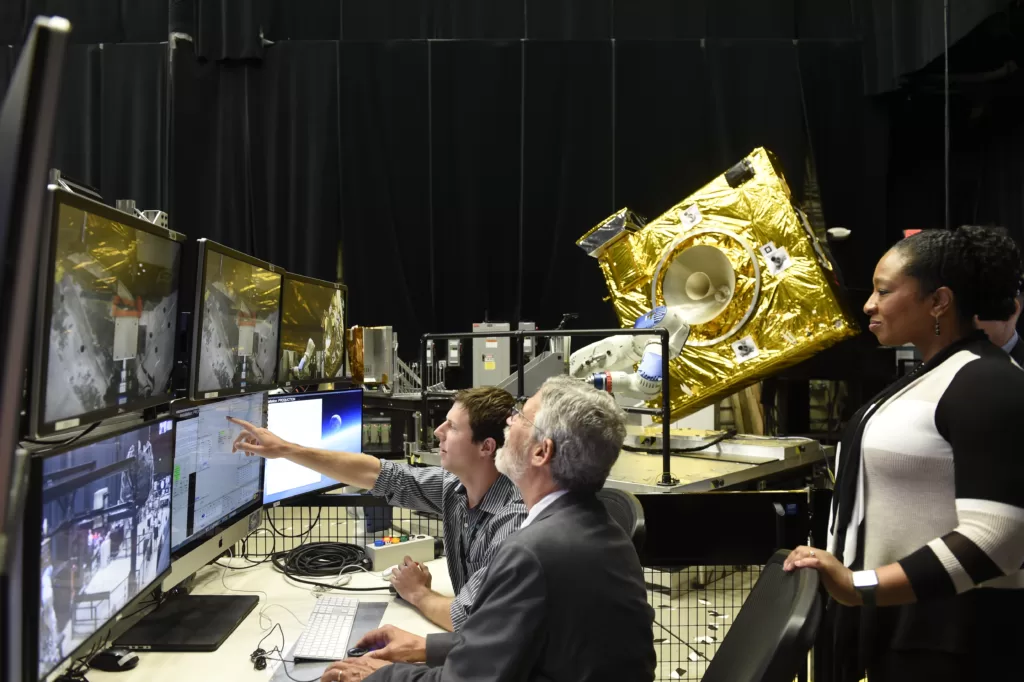It was a few white lines on a black screen, but Asteroids became Atari’s most popular arcade game.
 Asteroids Deluxe was released in 1981. Its vector graphics were tinted blue, the asteroids spun, and new ‘killer satellites’ aimed for the player’s spaceship, breaking into smaller satellites when fired upon. : Steven A. Miller, Flickr CC BY 2.0
Asteroids Deluxe was released in 1981. Its vector graphics were tinted blue, the asteroids spun, and new ‘killer satellites’ aimed for the player’s spaceship, breaking into smaller satellites when fired upon. : Steven A. Miller, Flickr CC BY 2.0
It was a few white lines on a black screen, but Asteroids became Atari’s most popular arcade game.
The little wedge-shaped spaceship thrusts and drifts across the screen, firing at dangerous obstacles around it. The two-note soundtrack gradually increases its pace, growing more suspenseful. Despite firing at the objects around it, the spaceship is now surrounded by more objects than when it began. A button press sends the spaceship into hyperspace, narrowly avoiding a collision, but the spaceship randomly reappears somewhere just as dangerous, and is destroyed by a passing asteroid. Game over.
Designed by Atari’s Lyle Rains and Ed Logg, the arcade game Asteroids was released in November 1979, and went on to become Atari’s most popular arcade game. The spaceship and the floating asteroids are all simple forms of a few white lines set on a background of black, but the thrilling gameplay was enough to get players to spend quarter after quarter; in 1981 alone, Americans put 20 billion quarters through arcade games, playing 75,000 man-hours on them.
Two aspects of Asteroids – its wraparound screen and the way asteroids are destroyed – helped make the game a stunning success. The idea of a ‘wraparound’ screen had been around since Spacewar! (1962). Objects leaving the top of the screen re-entered from the bottom of the screen, and vice versa; likewise, objects passing out of the left side of the screen would re-enter on the right, and vice versa. Before Asteroids, however, player vehicles and missiles were the only things passing in and out of the screen boundaries. In Asteroids, the number of objects moving on-screen and off-screen is far greater, and can even be in the dozens. This is due to the way the asteroids are destroyed: players start the game with a handful of large asteroids floating around the screen, and shooting at them breaks the large asteroid into two medium-sized asteroids. When fired upon, each medium-sized asteroid explodes into two smaller ones. Only the smallest asteroids, when hit, will vanish completely and the smaller the asteroid, the harder it is to hit.
Players needed to learn how to fly their spaceship (the only controls were thrust, turn and hyperspace), and they had to be aware of what was happening on all sides of the screen. Their attempts to rid the screen of asteroids created more asteroids and increased the number of floating objects that could collide with the player’s ship, making the gamespace ever more dangerous as it continued.
Amid the high-pitched firing sounds, low-pitched explosions of asteroids, and ominous soundtrack with its ever-increasing pace, occasional sirens also indicated the arrival of flying saucers that fire on the player’s craft, giving the player yet more danger to avoid.
Asteroids had simple, monochrome vector graphics (made up of lines) and a simple premise, but simplicity does not mean a game cannot be difficult – or fun – and Asteroids was both. In 1981, a sequel, Asteroids Deluxe, was released in arcades. The vector graphics were tinted blue, the asteroids spun, and new ‘killer satellites’ aimed for the player’s spaceship, breaking into smaller satellites when fired upon. Atari’s Space Duel (1982) and Blasteroids (1987) added further innovations and more detailed graphics, but the core idea remained the same.
As time went on, video games evolved full-colour raster graphics and later, three-dimensional graphics, both of which are standard today. Vector-graphic arcade games, which used a different kind of monitor, would no longer be made. Later, during the 1990s, as home game console technology began catching up to arcade games, the decline of the arcades would begin, and most arcades would be closed by the end of the decade.
But Asteroids lived on; Atari ported the game to its home console systems, to the Atari VCS 2600 in 1981, and to the Atari 7800 in 1986. As these versions had raster graphics, the asteroids were solid colours. Instead of just being line drawings, the asteroids of the 7800 version even had texture. Later, gaming company Activision would port the game to other consoles and platforms, including the PlayStation and Microsoft Windows in 1998, the Nintendo 64 and Game Boy Color in 1999, and the Apple Macintosh computer in 2000. Playable online versions of Asteroids can also be found (for example, at https://freeasteroids.org/). And where did all the original arcade machines of Asteroids go? Into the homes of collectors. Sometimes they are put up for sale – arcade machines of Asteroids were recently selling for just over $2000 on eBay.
Video games exploded onto a variety of platforms, and thousands of new games were released in a wide variety of styles from high budget, high profile ‘triple-A’ games to independent games and from photorealistic graphics to simple abstractions. Some were even deliberately designed to look like older games. Their worth once measured in quarters, video games are now a market worth US$173.7 billion in 2020 – and that is expected to grow to US$314.4 billion by 2026. Amid it all, Asteroids managed to stay in the public’s memory. It has appeared in the background of dozens of movies and television shows, from E.T.: The Extraterrestrial (1982) to Ready Player One (2018), and sometimes is even played by their characters or mentioned in their dialogue.
The game is still available, and whatever version you may play, Asteroids, like its contemporaries Pac-Man (1980) and Battlezone (1980), remains a classic video game that will always be around in one form or another, making it available for new generations of players to try – and for older generations to play as they remember and reminisce.
Dr Mark J. P. Wolf (ORCID 0000-0003-1608-5814) is a Professor at Concordia University Wisconsin. His books include The Medium of the Video Game (2001), The Video Game Theory Reader (2003), The Video Game Explosion (2007), The Video Game Theory Reader 2 (2008), Before the Crash: Early Video Game History (2012), The Encyclopedia of Video Games (1st edition 2012; 2nd edition 2021), The Routledge Companion to Video Game Studies (2014), Video Games Around the World (2015) and Video Games FAQ (2017).
Dr Wolf has declared no conflict of interest in relation to this article.
This article was originally published in June 2022.
Originally published under Creative Commons by 360info™.














